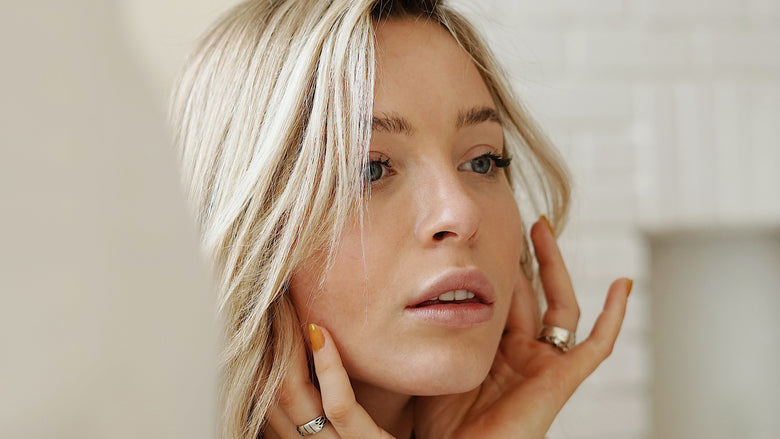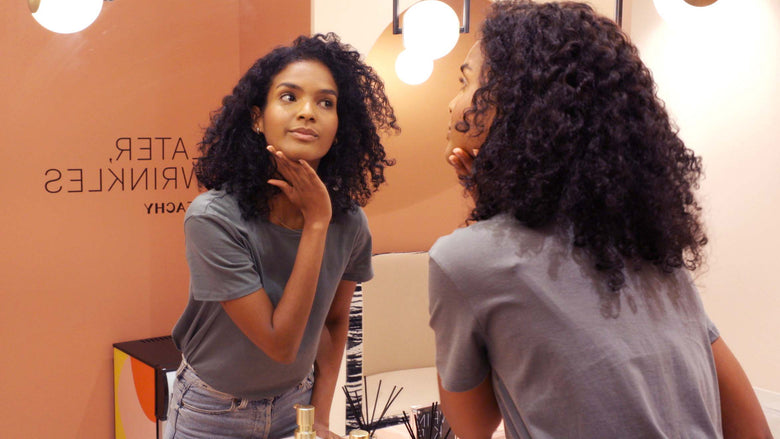Ever wondered about those lateral lines showing above the brow? Those are your forehead lines, or “worry lines,” and they’re a byproduct of a complex facial muscle known as the frontalis muscle.
Like any other wrinkle, these lines surface over time as your complexion matures. With this, you may notice less elasticity or structure in the skin, or perhaps more texturing or pigmentation, and that’s okay. It’s completely normal for skin to age!
Our focus at Peachy is preventing and reversing the day-to-day exposure linked to wrinkles (looking at you, UV rays) through a holistic and data-driven approach that leads to fewer and finer lines along the forehead and elsewhere.
Not all wrinkles are the same
Whether you’re on the fence about botox or thinking increasingly more about it, it might be a good idea to first see what your mirror says.
Beyond that reflection full of verve and delight, what do you see? Fine lines when you hike an eyebrow or show surprise? Lines that remain even after the face is at rest?
There are in fact two kinds of wrinkles: dynamic and static.
Dynamic forehead wrinkles are those that show during a movement or facial expression but then go away afterward. As our skin ages, it gradually loses elasticity through repeated, day-to-day muscle movement – this leads to dynamic lines.
Squinting, showing surprise, and simply enjoying life through expression are all common causes.
Static forehead wrinkles, by contrast, are those that remain even when the face is at rest. They are a result of dynamic lines left untreated, leading to collagen breakdown in the skin. Other primary contributors of static wrinkles include sun exposure, genetics, a poor diet, and smoking.
Treating forehead wrinkles
When it comes to diminishing and preventing lines along the forehead, botox is one of the best options available – both in effectiveness and safety.
While it may be a catch-all term, Botox® is in fact a specific brand of wrinkle relaxers that helps to correct the appearance of forehead wrinkles.
It is often viewed as the wrinkle relaxer treatment, but that’s not quite true. There are actually multiple FDA-approved brands which serve the same wrinkle-fighting function as Botox®. These include Xeomin®, Jeuveau®, and Dysport®.
Beneath the skin, botox works by targeting particular facial muscles (the ones causing wrinkles to form), helping them to contract less with use. The act of relaxing specific muscles is what releases subtle strains in skin along the forehead – giving your complexion that naturally supple look, without altering your actual appearance.
Timing your treatment
Wrinkle prevention isn’t a quick fix. It’s an extension of self-care practiced over time. If finer lines and fewer of them is your goal, routine wrinkle treatment is a clear path to get there.
While earlier is better for purposes of prevention, there isn’t a “right” time to begin treating wrinkles. The decision is a personal one that comes down to a person’s existing wrinkle burden and the complexion goals they have. That said, there are a few signs it might be time to consider:
- Where you notice lines taking form with facial expressions.
- Lines that remain when the face is at rest.
- If you’re wanting to prevent wrinkles before they form.
Cadencing
Worth noting is that the effects from botox will gradually reduce over time as the body goes about metabolizing the treatment. This is why routine treatments are essential to keep existing wrinkles from advancing and new ones from surfacing; the recommended frequency for botox is every three to four months.
Routine doesn’t mean expensive
Contrary to popular belief, the cost of botox isn’t high by default. It will depend on where you’re going for treatment and how the provider structures pricing. Many conventional practices, for example, base service cost on the number of units your face needs. This is more common in doctors offices and med spas.
For forehead lines, this is especially disadvantageous. Why? The muscle involved, the fontalis, is naturally prominent and requires more units to relax. And with botox priced between $15 and $20 per unit (not including cost to administer treatment) this means the price can get unaffordable rather quickly.
Moreover, the estimate you get from providers is just that: an estimate. Meaning you often won’t know how much treatment you actually need until it’s done!
At Peachy, we’ve priced botox for men and women more purposefully: $425 for your ideal dose, for all three FDA-approved areas of the face. No catches, no added expenses.
We’re different
We don’t rely on guesswork – We bring a data-driven mindset to wrinkle treatment where others use intuition. This we do by focusing on the three FDA-approved areas of the face – areas known to respond well to botox.
We’re radically transparent – Transparency has been a major sticking point in botox care up to now, and it’s something most providers actively struggle with. Much of this comes down to the care model the provider has in place. With the cost of preventative botox set at $425, you know just how much you’ll pay for the amount you need.
We’re all about holistic – Where other providers see wrinkles to treat, we see complexion goals. For us it’s more than simply treating wrinkles. It’s about preventing them! At Peachy we’ve built an entire strategy around complexion care, pairing preventative botox with prescription retinoids and daily-use SPF, to keep lines along the forehead – and beyond – in check. with a Peachy Provider today. We can’t wait to see you in the studio!




